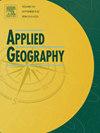基于纵向设计的中国建成环境与成人心理健康的非线性交互关联
IF 5.4
2区 地球科学
Q1 GEOGRAPHY
引用次数: 0
摘要
我们利用2010年和2014年中国家庭调查(CFPS)的数据,试图调查中国建筑环境与心理健康之间的纵向非线性和交互关联。我们采用XGBoost模型来研究建筑环境的变化与心理健康的变化之间的关系。我们观察到建筑环境对心理健康的纵向非线性阈值效应:当社区吸引力增加到4个单元,医疗设施数量增加到10个时,居住在社区的参与者更有可能拥有更好的心理健康。相比之下,早期教育设施数量的大幅增加(8至12个)与心理健康呈负相关。此外,社区吸引力的提高和医疗设施数量的增加共同增强了心理健康效益。这些发现的含义包括,确定建筑环境特征的阈值对于实现最佳的心理健康效益至关重要。此外,重要的是将多种建筑环境特征整合在一起,以扩大心理健康效益。干预策略应根据具体的地理环境进行调整,以优先改善建筑环境特征。本文章由计算机程序翻译,如有差异,请以英文原文为准。
Nonlinear interactive associations between built environments and adults’ mental health in China using a longitudinal design
We attempted to investigate longitudinal nonlinear and interactive associations between built environments and mental health in China, using data from China Family Panel Studies (CFPS) in 2010 and 2014. We employed the XGBoost model to examine how changes in built environments were related to changes in mental health. We observed longitudinal nonlinear threshold effects of built environments on mental health: participants living in neighborhoods with the increase in neighborhood attractiveness reaching to 4-unit and the increase in the quantity of medical facilities reaching to 10 were more likely to have better mental health. In contrast, a substantial increase (between 8 and 12) in the quantity of early education facilities was negatively associated with mental health. Further, improvement in neighborhood attractiveness and increase in the quantity of medical facilities together strengthened mental health benefits. The implications of these findings include that it is critical to identify the threshold for built environment features to achieve optimal mental health benefits. Besides, it is important to integrate multiple built environment features together to amplify the mental health benefits. Intervention strategies should be tailored to specific geographic contexts to prioritize improving built environment features.
求助全文
通过发布文献求助,成功后即可免费获取论文全文。
去求助
来源期刊

Applied Geography
GEOGRAPHY-
CiteScore
8.00
自引率
2.00%
发文量
134
期刊介绍:
Applied Geography is a journal devoted to the publication of research which utilizes geographic approaches (human, physical, nature-society and GIScience) to resolve human problems that have a spatial dimension. These problems may be related to the assessment, management and allocation of the world physical and/or human resources. The underlying rationale of the journal is that only through a clear understanding of the relevant societal, physical, and coupled natural-humans systems can we resolve such problems. Papers are invited on any theme involving the application of geographical theory and methodology in the resolution of human problems.
 求助内容:
求助内容: 应助结果提醒方式:
应助结果提醒方式:


